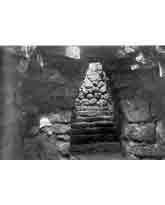Tel Megiddo Centennial – Year 2002 Season
David Ussishkin, Tel Aviv University
Tel Megiddo is one of the most important tells of the biblical period in Israel. Early settlement at Megiddo developed as a result of three factors: (1) springs on two sides of the tell; (2) fertile soil; (3) its location near Wadi `Iron, the major travel route from Egypt (Africa) to Syria (Asia). This strategic location was of special military significance in ancient times. Many battles took place here throughout history, and its name is related to them. It is not surprising that in Christian tradition, Megiddo has become Armageddon – the place of the last battle between the forces of light and the forces of darkness. Settlement at Tel Megiddo had already begun in the pre-pottery Neolithic era, probably in the eighth millennium BCE, and saw continuous habitation until the Roman period and later, in a large area south of the tell.

The archaeological excavation of Megiddo began on April 1, 1903 by Dr. Gottlieb Schumacher on behalf of the German Society for Eretz-Israel Research. Schumacher excavated Megiddo for three years, concentrating mainly on the deep channel crossing the tell from north to south, reaching bedrock in one section. Most of the finds were sent to the Archaeological Museum in Berlin, known today as the Pergamon Museum.
In 1925, a delegation from the Oriental Institute of the University of Chicago began excavation, and continued, on a large and unprecedented scale, until the outbreak of the Second World War. The American expedition had intended to excavate the entire tell, layer after layer, but in the end, only part of the tell was excavated. In a large area on the eastern side of the tell, the excavators reached bedrock. The excavated rubble was piled up to the east, a testament, still visible, to the huge amount of work invested there.
In the 1960s and 70s, a number of short excavation seasons took place, led by Prof. Yigael Yadin on behalf of the Hebrew University. The aim of these excavations was to examine Israelite Kingdom remains.

In 1992, excavation by the Institute of Archaeology of Tel Aviv University began, directed by Professor Yisrael Finkelstein, the writer of this article, and Professor Baruch Halpern of Pennsylvania State University. Professor Halpern headed a consortium of international academic organizations participating in the long-term excavation project, to methodically study Megiddo’s archaeology and history.
Excavation continues in one of the areas in which Schumacher dug, one hundred years ago. Part of the large channel he excavated along the tell remains until today, and contains the imposing tomb, as he found it. It is a unique cave built with planed stones. An entry pit leads to an arched opening into the burial chamber. It was found empty, and therefore very difficult to date. The accepted view is that the tomb probably dates to the second millennium BCE. It is built in the Syrian-Aegean style of that time. The latest excavations are planned to examine this entire area. Close above the tomb, remains of a large and stately public building are being uncovered, whose size and function are still unknown. The building is in layer VI – the large city destroyed in the tenth century BCE, apparently by Israelite kings. The building itself was destroyed by fire, and piles of burnt bricks from the collapsed walls offer impressive evidence. The relation between the building and tomb is still not clear; it appears that the tomb preceded the building, perhaps already in Layer VII of the twelfth century BCE, but it is clear that the building in layer VI was related to the tomb in some way. There is hope that all will come clear in the next excavation season.
Additional Articles ...